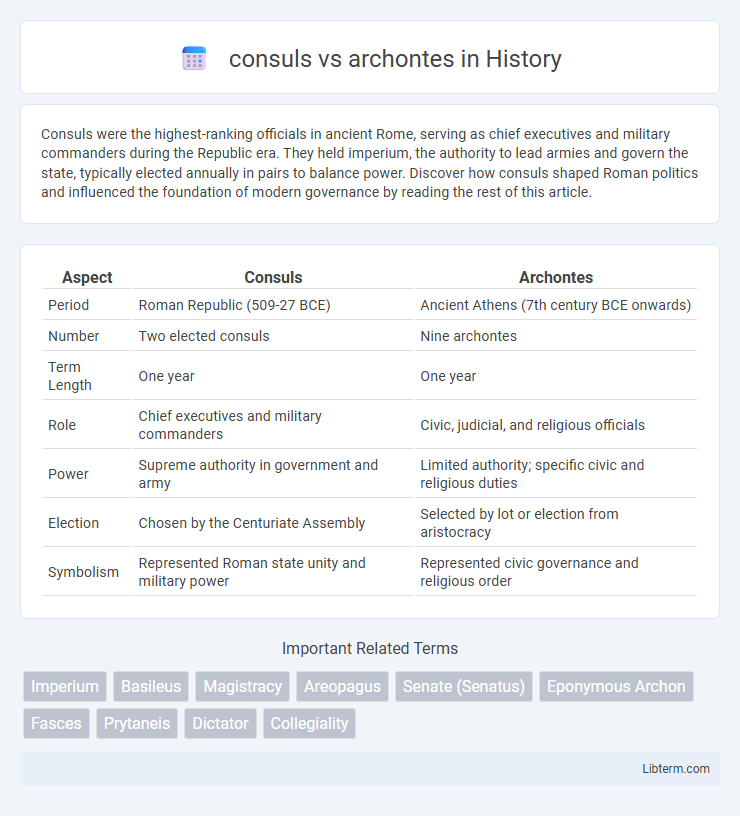Consuls were the highest-ranking officials in ancient Rome, serving as chief executives and military commanders during the Republic era. They held imperium, the authority to lead armies and govern the state, typically elected annually in pairs to balance power. Discover how consuls shaped Roman politics and influenced the foundation of modern governance by reading the rest of this article.
Table of Comparison
| Aspect | Consuls | Archontes |
|---|---|---|
| Period | Roman Republic (509-27 BCE) | Ancient Athens (7th century BCE onwards) |
| Number | Two elected consuls | Nine archontes |
| Term Length | One year | One year |
| Role | Chief executives and military commanders | Civic, judicial, and religious officials |
| Power | Supreme authority in government and army | Limited authority; specific civic and religious duties |
| Election | Chosen by the Centuriate Assembly | Selected by lot or election from aristocracy |
| Symbolism | Represented Roman state unity and military power | Represented civic governance and religious order |
Introduction to Consuls and Archontes
Consuls and archontes were key political leaders in ancient Rome and Athens, respectively, serving as chief magistrates with executive powers. Consuls, elected annually in pairs during the Roman Republic, wielded military and administrative authority while archontes, originally nine in number, held various civic and religious responsibilities in Athens. Both offices evolved over time, reflecting the political dynamics and governance structures of their respective city-states.
Historical Context: Rome vs Athens
Consuls in Rome, elected annually, were the highest-ranking magistrates responsible for military command and civil administration during the Republic, reflecting Rome's pragmatic and hierarchical governance structure. Archontes in Athens, originally monarch-like officials, evolved into a group of nine magistrates who shared judicial, religious, and military duties, illustrating Athens' shift toward a more collective and participatory political system. The contrast highlights Rome's emphasis on centralized executive power versus Athens' early development of oligarchic elements paving the way for democracy.
Roles and Functions: Consuls Explained
Consuls in ancient Rome served as the highest-ranking magistrates responsible for commanding the army, presiding over the Senate, and executing laws, wielding both civil and military authority. Archontes in ancient Athens primarily held religious and judicial duties, overseeing civic rituals and legal disputes without the extensive executive powers found in Roman consuls. The consulship combined political leadership with military command, making consuls pivotal in shaping Roman governance and state policy.
Duties and Powers: The Archontes System
The archontes system in ancient Athens involved nine magistrates responsible for religious, judicial, and military duties, with the archon eponymous overseeing civil affairs and the archon basileus managing religious rites, emphasizing their administrative and sacred roles. In contrast, Roman consuls held supreme executive power, commanding armies, presiding over the Senate, and administering the government, reflecting a broader scope of political and military authority. The archontes' powers were more specialized and symbolic, focusing on maintaining tradition and legal order, whereas consuls exercised greater political control and state leadership.
Selection and Tenure: Election of Consuls and Archontes
Consuls in ancient Rome were elected annually by the Centuriate Assembly, serving one-year terms to ensure accountability and prevent concentration of power, while Archontes in Athens were typically selected through a combination of election and allotment, often serving for one year or longer depending on the specific archonship. Roman consuls were usually patricians or elected representatives overseeing military and civil duties, whereas Athenian archontes held religious, judicial, and administrative roles with some positions reserved for aristocrats. The differing selection methods reflect Rome's emphasis on electoral legitimacy versus Athens' blend of democratic and aristocratic principles in governance.
Political Influence and Authority
Consuls in the Roman Republic wielded significant political influence as chief magistrates with imperium, commanding the army and presiding over the Senate, reflecting their central role in governance and military affairs. Archontes, primarily in ancient Athens, held important but more limited authority, overseeing religious duties, judicial functions, and certain civic responsibilities without comparable military power. The consulship combined executive, military, and judicial authority, while archontes' influence was more diffused and specialized within the polis's political structure.
Legal and Military Responsibilities
Consuls in the Roman Republic held supreme legal authority, presiding over civil and criminal courts while commanding the legions in military campaigns. Archontes in ancient Athens primarily possessed judicial powers, overseeing religious and civil laws, with limited military command often delegated to strategoi. Roman consuls combined executive, judicial, and military roles, whereas Athenian archontes functioned mainly as magistrates with more specialized and restricted responsibilities.
Social Class and Eligibility
Consuls in ancient Rome were typically drawn from the patrician class or wealthy plebeians who had completed the cursus honorum, reflecting elite social status and political experience. Archontes in classical Athens generally belonged to the aristocratic Eupatridae class, with eligibility often restricted to noble lineage and property qualifications. Both offices demonstrated a strong link between social class and political eligibility, underscoring the oligarchic nature of early governance systems in Rome and Athens.
Key Differences Between Consuls and Archontes
Consuls were the chief magistrates in the Roman Republic, holding executive authority and commanding armies, while archontes were magistrates in ancient Athens with primarily religious and judicial functions. Consuls served for one-year terms with significant military and political power, whereas archontes' roles were often limited to administrative and ceremonial duties, typically with longer or life terms in earlier periods. The consulship was a cornerstone of Roman republican governance emphasizing separation of powers, contrasting with the archontes' role in the more aristocratic and evolving democratic Athenian system.
Legacy and Impact on Modern Governance
Consuls of ancient Rome established the framework for executive leadership with dual magistracy and term limits, influencing the balance of power in modern republics. Archontes of classical Athens contributed to early forms of civic administration and judicial oversight, shaping principles of democratic governance and accountability. Their legacies endure in contemporary systems through concepts of separation of powers, rotation in office, and citizen participation in government.
consuls Infographic

 libterm.com
libterm.com